Modelling Water and Pesticide Transport in Soil with MACRO 5.2: Calibration with Lysimetric Data
Abstract
:1. Introduction
2. Materials and Methods
2.1. Pesticide
2.2. Lysimeter Experiment
2.3. Pesticide Analysis
2.4. Model MACRO (Version 5.2)
2.5. Model Parameters of MACRO
2.6. Estimation of Model Accuracy
3. Results
3.1. Water Transport Modelling
3.2. Migration of Cyantraniliprole in the Experiment
3.3. Modelling Cyantraniliprole Migration
4. Discussion
5. Conclusions
Author Contributions
Funding
Informed Consent Statement
Data Availability Statement
Acknowledgments
Conflicts of Interest
References
- Blanchoud, H.; Farrugia, F.; Mouchel, J.M. Pesticide Uses and Transfers in Urbanised Catchments. Chemosphere 2004, 55, 905–913. [Google Scholar] [CrossRef] [PubMed]
- Hildebrandt, A.; Guillamón, M.; Lacorte, S.; Tauler, R.; Barceló, D. Impact of Pesticides Used in Agriculture and Vineyards to Surface and Groundwater Quality (North Spain). Water Res. 2008, 42, 3315–3326. [Google Scholar] [CrossRef] [PubMed]
- Herrero-Hernández, E.; Andrades, M.; Alvarez-Martin, A.; Pose-Juan, E.; Rodríguez-Cruz, M.S.; Sánchez-Martín, M. Occurrence of Pesticides and Some of Their Degradation Products in Waters in a Spanish Wine Region. J. Hydrol. 2013, 486, 234–245. [Google Scholar] [CrossRef]
- Vega, A.; Frenich, A.; Vidal, J. Monitoring of Pesticides in Agricultural Water and Soil Samples from Andalusia by Liquid Chromatography Coupled to Mass Spectrometry. Anal. Chim. Acta 2005, 538, 117–127. [Google Scholar] [CrossRef]
- Carter, A.D. Herbicide Movement in Soils: Principles, Pathways and Processes. Weed Res. 2000, 40, 113–122. [Google Scholar] [CrossRef]
- FOCUS (FOrum for Co-Ordination of Pesticide Fate Models and Their Use). FOCUS Groundwater Scenarios in the EU Review of Active Substances: Report of the FOCUS Groundwater Scenarios Workgroup EC Document Reference Sanco/321/ 2000 Rev.2. 2000; 202p. Available online: https://esdac.jrc.ec.europa.eu/public_path/projects_data/focus/gw/docs/FOCUS_GW_Report_Main.pdf (accessed on 24 February 2022).
- Larsbo, M.; Jarvis, N. MACRO 5.0: A Model of Water Flow and Solute Transport in Macroporous Soil, Technical Description. Available online: https://www.yumpu.com/en/document/view/28675249/users-guide-to-macro50-a-model-of-water-flow-and-solute (accessed on 24 February 2022).
- Leistra, M.; van der Linden, A.M.A.; Boesten, J.; Tiktak, A.; van der Berg, F. PEARL Model for Pesticide Behaviour and Emissions in Soil-Plant Systems; Description of the Processes in FOCUS PEARL v 1.1.1; Wageningen Environmental Research: Wageningen, The Netherlands, 2001; p. 115. [Google Scholar]
- Klein, M. PELMO Pesticide Leaching Model, Version 2.01, User’s Manual; Fraunhofer-Institut fur Umweltchemie und Okotoxikolgie: Schmallenberg, Germany, 1995. [Google Scholar]
- Carsel, R.; Imhoff, J.; Hummel, P.; Cheplick, J.; Donigian, A.; Suarez, L. PRZM-3, a Model for Predicting Pesticide and Nitrogen Fate in the Crop Root and Unsaturated Soil Zones: User’s Manual for Release 3.12.2; US Environmental Protection Agency (EPA): Washington, DC, USA, 2005.
- Vanclooster, M.; Boesten, J.; Trevisan, M.; Brown, C.; Capri, E.; Eklo, O.; Gottesbüren, B.; Gouy, V.; Linden, A.M.A. A European Test of Pesticide-Leaching Models: Methodology and Major Recommendations. Agric. Water Manag. 2000, 44, 1–19. [Google Scholar] [CrossRef]
- Scorza, R., Jr.; Boesten, J. Simulation of Pesticide Leaching in a Cracking Clay Soil with the PEARL Model. Pest Manag. Sci. 2005, 61, 432–448. [Google Scholar] [CrossRef]
- Kolupaeva, V.; Gorbatov, V.; Kokoreva, A. Comparison of PEARL and MACRO_DB Simulations in the Unsaturated Zone Using Lysimeter Experiment Data. In Environmental Fate and Ecological Effects of Pesticides; Re, A.A.M.D., Capri, E., Fragoulis, G., Trevisan, M., Eds.; La Goliardica Pavese s.r.l.: Pavia, Italy, 2007; pp. 497–502. [Google Scholar]
- Shein, E.; Belik, A.; Kokoreva, A.; Kolupaeva, V. Quantitative Estimate of the Heterogeneity of Solute Fluxes Using the Dispersivity Length for Mathematical Models of Pesticide Migration in Soils. Eurasian Soil Sci. 2018, 51, 797–802. [Google Scholar] [CrossRef]
- Zappa, G.; Bersezio, R.; Felletti, F.; Giudici, M. Modeling Heterogeneity of Gravel-Sand, Braided Stream, Alluvial Aquifers at the Facies Scale. J. Hydrol. 2006, 325, 134–153. [Google Scholar] [CrossRef]
- Vassena, C.; Cattaneo, L.; Giudici, M. Assessment of the Role of Facies Heterogeneity at the Fine Scale by Numerical Transport Experiments and Connectivity Indicators. Appl. Hydrogeol. 2010, 18, 651–668. [Google Scholar] [CrossRef]
- Šimůnek, J.; Jarvis, N.; Genuchten, M.V.; Gärdenäs, A.I. Review and Comparison of Models for Describing Non-Equilibrium and Preferential Flow and Transport in the Vadose Zone. J. Hydrol. 2003, 272, 14–35. [Google Scholar] [CrossRef]
- Dubus, I.G.; Beulke, S.; Brown, C.D.; Gottesbüren, B.; Dieses, A. Inverse Modelling for Estimating Sorption and Degradation Parameters for Pesticides. Pest Manag. Sci. 2004, 60, 859–874. [Google Scholar] [CrossRef] [PubMed]
- Beulke, S.; Dubus, I.; Brown, C.; Gottesbüren, B. Simulation of Pesticide Persistence in the Field on the Basis of Laboratory Data—A Review. J. Environ. Qual. 2000, 29, 1371–1379. [Google Scholar] [CrossRef]
- Vereecken, H.; Vanderborght, J.; Kasteel, R.; Spiteller, M.; Schäffer, A.; Close, M. Do Lab-Derived Distribution Coefficient Values of Pesticides Match Distribution Coefficient Values Determined from Column and Field-Scale Experiments? A Critical Analysis of Relevant Literature. J. Environ. Qual. 2011, 40, 879–898. [Google Scholar] [CrossRef]
- Scorza, R.P., Jr.; Jarvis, N.J.; Boesten, J.J.; van der Zee, S.E.; Roulier, S. Testing MACRO (Version 5.1) for Pesticide Leaching in a Dutch Clay Soil. Pest Manag. Sci. 2007, 63, 1011–1025. [Google Scholar] [CrossRef] [Green Version]
- Nolan, B.T.; Dubus, I.G.; Surdyk, N. A Refined Lack-of-Fit Statistic to Calibrate Pesticide Fate Models for Responsive Systems. Pest Manag. Sci. 2009, 65, 1367–1377. [Google Scholar] [CrossRef]
- Marín-Benito, J.M.; Pot, V.; Alletto, L.; Mamy, L.; Bedos, C.; Barriuso, E.; Benoit, P. Comparison of Three Pesticide Fate Models with Respect to the Leaching of Two Herbicides under Field Conditions in an Irrigated Maize Cropping System. Sci. Total Environ. 2014, 499, 533–545. [Google Scholar] [CrossRef]
- Shein, E.; Kokoreva, A.; Gorbatov, V.; Umarova, A.; Kolupaeva, V.; Perevertin, K.A. Sensitivity Assessment, Adjustment, and Comparison of Mathematical Models Describing the Migration of Pesticides in Soil Using Lysimetric Data. Eurasian Soil Sci. 2009, 42, 769–777. [Google Scholar] [CrossRef]
- Marín-Benito, J.; Mamy, L.; Carpio, M.; Sánchez-Martín, M.; Rodriguez-Cruz, S. Modelling Herbicides Mobility in Amended Soils: Calibration and Test of PRZM and MACRO. Sci. Total Environ. 2020, 717, 137019. [Google Scholar] [CrossRef]
- Kolupaeva, V.N.; Gorbatov, V.S.; Shein, E.V.; Leonova, A.A. The Use of the PEARL Model for Assessing the Migration of Metribuzin in Soil. Eurasian Soil Sci. 2006, 39, 597–603. [Google Scholar] [CrossRef]
- Baratelli, F.; Giudici, M.; Vassena, C. Single and Dual-Domain Models to Evaluate the Effects of Preferential Flow Paths in Alluvial Sediments. Transp. Porous Media 2011, 87, 465–484. [Google Scholar] [CrossRef]
- Roulier, S.; Jarvis, N. Modeling Macropore Flow Effects on Pesticide Leaching: Inverse Parameter Estimation Using Microlysimeters. J. Environ. Qual. 2003, 32, 2341–2353. [Google Scholar] [CrossRef] [PubMed] [Green Version]
- Jarvis, N.J. MACRO (V5.2): Model Use, Calibration, and Validation. Trans. ASABE 2012, 55, 1413–1423. [Google Scholar] [CrossRef]
- Jarvis, N.; Larsbo, M.; Roulier, S.; Lindahl, A.; Persson, L. The Role of Soil Properties in Regulating Non-Equilibrium Macropore Flow and Solute Transport in Agricultural Topsoils. Eur. J. Soil Sci. 2007, 58, 282–292. [Google Scholar] [CrossRef]
- PPDB—Pesticide Properties Database. Available online: https://sitem.herts.ac.uk/aeru/ppdb/en/ (accessed on 28 February 2022).
- Kolupaeva, V.; Kokoreva, A.; Belik, A.; Pletenev, P. Study of the Behavior of the New Insecticide Cyantraniliprole in Large Lysimeters of the Moscow State University. Open Agric. 2019, 4, 599–607. [Google Scholar] [CrossRef]
- Kolupaeva, V.; Nyukhina, I.; Belik, A. Study of Cyantraniliprole Sorption in Soils of Russia. E3S Web Conf. 2020, 169, 01022. [Google Scholar] [CrossRef]
- Larsbo, M.; Jarvis, N. Simulating Solute Transport in a Structured Field Soil. J. Environ. Qual. 2005, 34, 621–634. [Google Scholar] [CrossRef] [Green Version]
- Vanclooster, M.; Pineros-Garcet, J.D.; Boesten, J.J.T.I.; Van den Berg, F.; Leistra, M.; Smelt, J.H.; Jarvis, N.; Burauel, P.; Vereecken, H.; Wolters, A.; et al. APECOP: Effective Approaches for Assessing the Predicted Environmental Concentrations of Pesticides—Final Report; Department of Environmental Sciences and Land Use Planning, Université Catholique de Louvain: Wallonia, Belgium, 2003; p. 158. [Google Scholar]
- Beulke, S.; Brown, C.D.; Jarvis, N.J. Macro: A Preferential Flow Model to Simulate Pesticide Leaching and Movement to Drains. In Modelling of Environmental Chemical Exposure and Risk; Linders, J.B.H.J., Ed.; Springer: Dordrecht, The Netherlands, 2001; pp. 117–132. [Google Scholar] [CrossRef]
- Umarova, A.B.; Arkhangelskaya, T.A.; Kokoreva, A.A.; Ezhelev, Z.S.; Shnyrev, N.A.; Kolupaeva, V.N.; Ivanova, T.V.; Shishkin, K.V. Long-term research on physical properties of soils in the large lysimeters of Moscow State University: Main results for the first 60 years (1961–2021). Mosc. Univ. Soil Sci. Bull. 2021, 76, 95–110. [Google Scholar] [CrossRef]
- Beulke, S.; Renaud, F.; Brown, C. Development of Guidance on Parameter Estimation for the Preferential Flow Model MACRO 4.2. Available online: https://www.semanticscholar.org/paper/Development-of-guidance-on-parameter-estimation-for-Beulke-Renaud/f6ce86c308ca6a038891b277e913cddb332533a4 (accessed on 24 February 2022).
- Shein, E.V. Granulometric Composition of Soils: Problems of Research Methods, Interpretation of Results and Classifications. Soil Sci. 2009, 3, 309–317. [Google Scholar]
- Umarova, A.B. Preferention Flows in Soils: Patterns of Formation and Significance in the Functioning of Soils; GEOS: Moscow, Russia, 2011; p. 266. ISBN 978-5-89118-562-3. [Google Scholar]
- Belik, A.A.; Kokoreva, A.A.; Bolotov, A.G.; Dembovetskii, A.V.; Kolupaeva, V.N.; Korost, D.V.; Khomyak, A.N. Characterizing Macropore Structure of Agrosoddy-Podzolic Soil Using Computed Tomography. Open Agric. 2020, 5, 888–897. [Google Scholar] [CrossRef]
- Ritter, A.; Muñoz-Carpena, R. Performance Evaluation of Hydrological Models: Statistical Significance for Reducing Subjectivity in Goodness-of-Fit Assessments. J. Hydrol. 2013, 408, 33–45. [Google Scholar] [CrossRef]
- Dubus, I.G.; Brown, C.D.; Beulke, S. Sensitivity Analyses for Four Pesticide Leaching Models. Pest Manag. Sci. 2003, 59, 962–982. [Google Scholar] [CrossRef] [PubMed]
- Evarte-Bundere, G.; Evarts-Bunders, P. Using of the Hydrothermal Coefficient (Htc) for Interpretation of Distribution of Non-Native Tree Species in Latvia on Example of Cultivated Species of Genus TILIA. Acta Biol. Univ. Daugavp. 2012, 12, 135–148. [Google Scholar]
- Beulke, S.; Brown, C.; Dubus, I.; Fryer, C.; Walker, A. Evaluation of Probabilistic Modelling Approaches against Data on Leaching of Isoproturon through Undisturbed Lysimeters. Ecol. Model. 2004, 179, 131–144. [Google Scholar] [CrossRef] [Green Version]
- Kolupaeva, V.N.; Gorbatov, V.S.; Nuhina, I.V. Determination of Transformation Parameters of Cyantraniliprole in Soddy-Podzolic Soil in Laboratory Conditions. Bull. NGAU Novosib. State Agrar. Univ. 2016, 2, 82–91. [Google Scholar]
- Umarova, A.; Ivanova, T. Dynamics of the Dispersity of Model Soddy-Podzolic Soils in a Long-Term Lysimetric Experiment. Eurasian Soil Sci. 2008, 41, 519–528. [Google Scholar] [CrossRef]
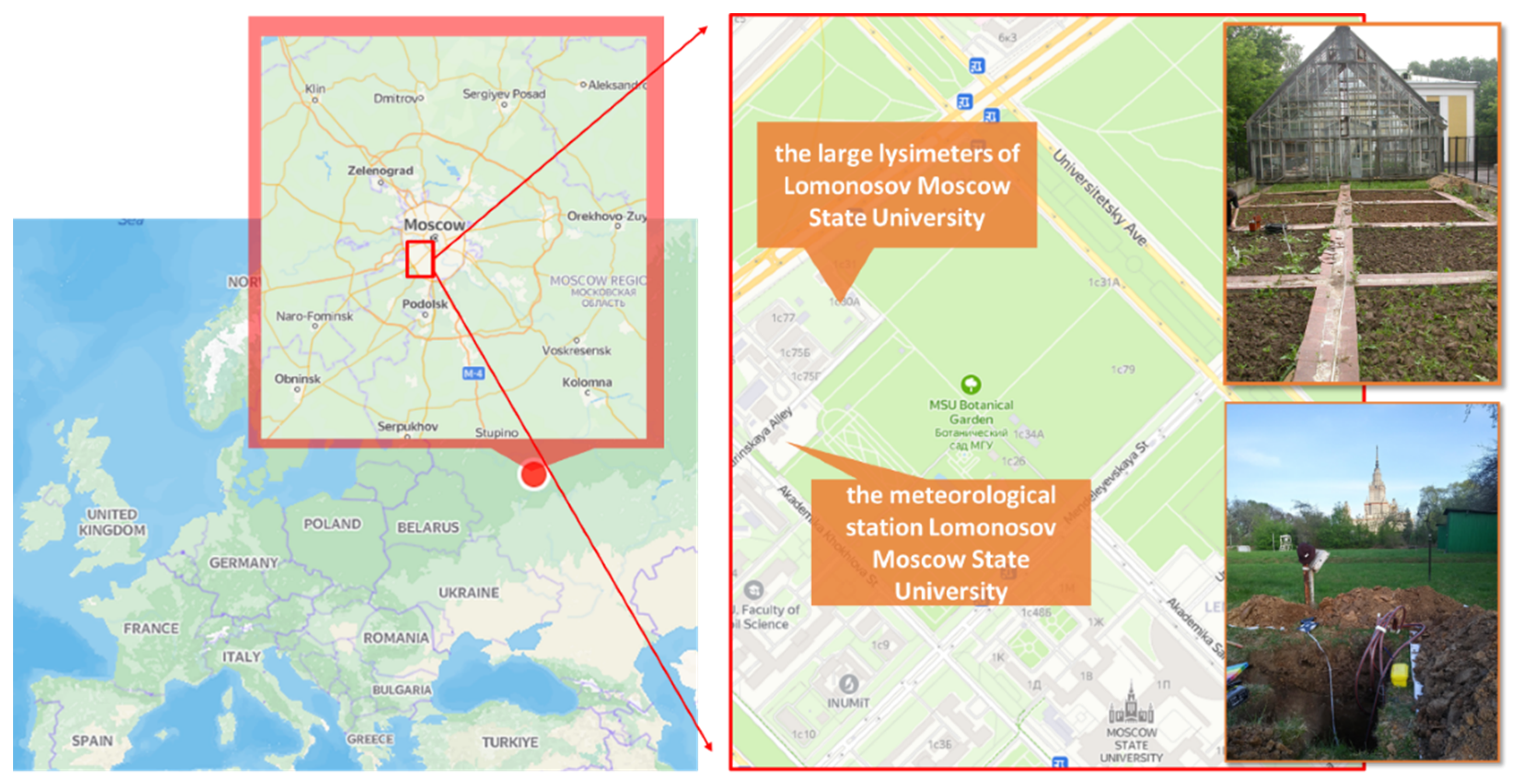

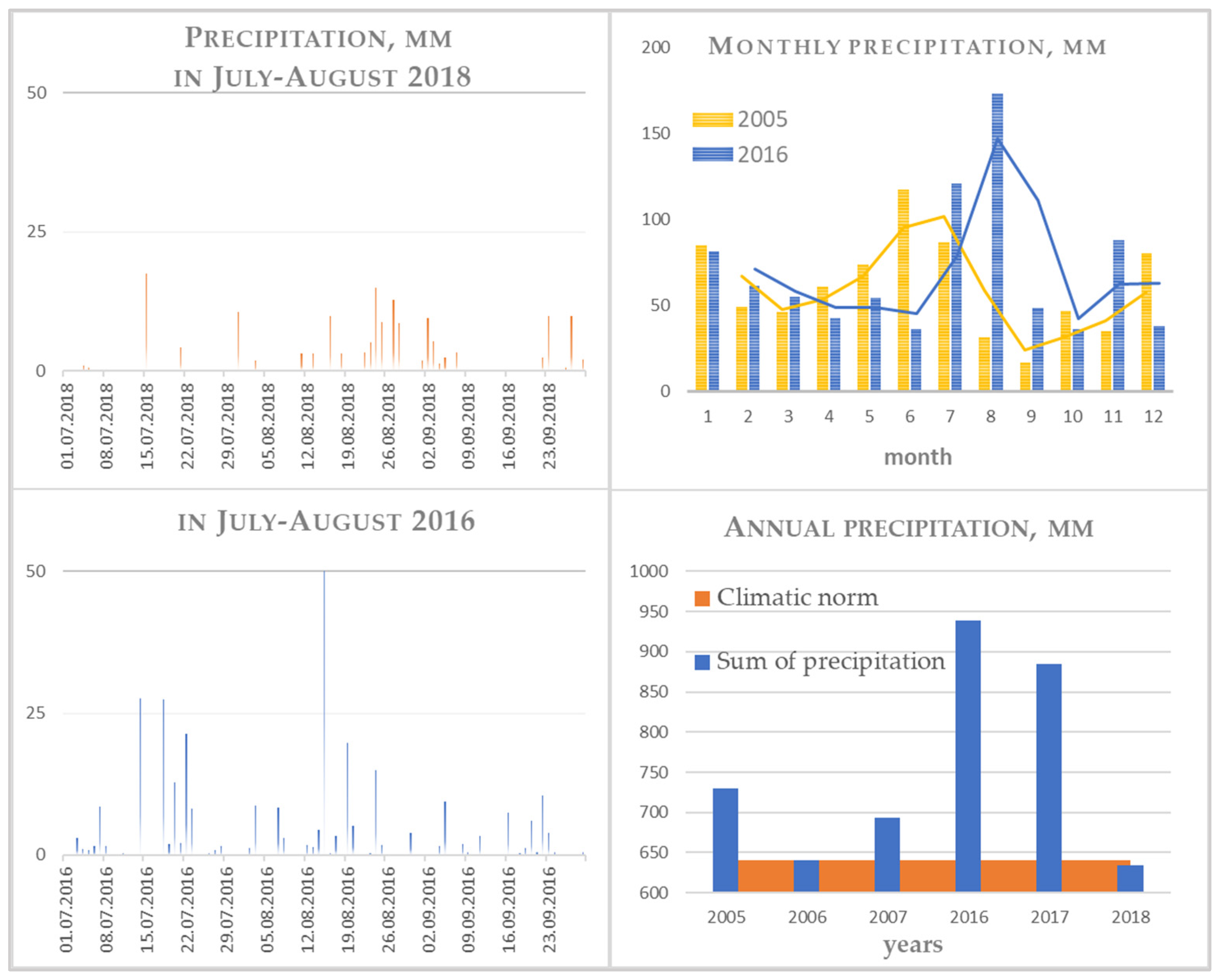
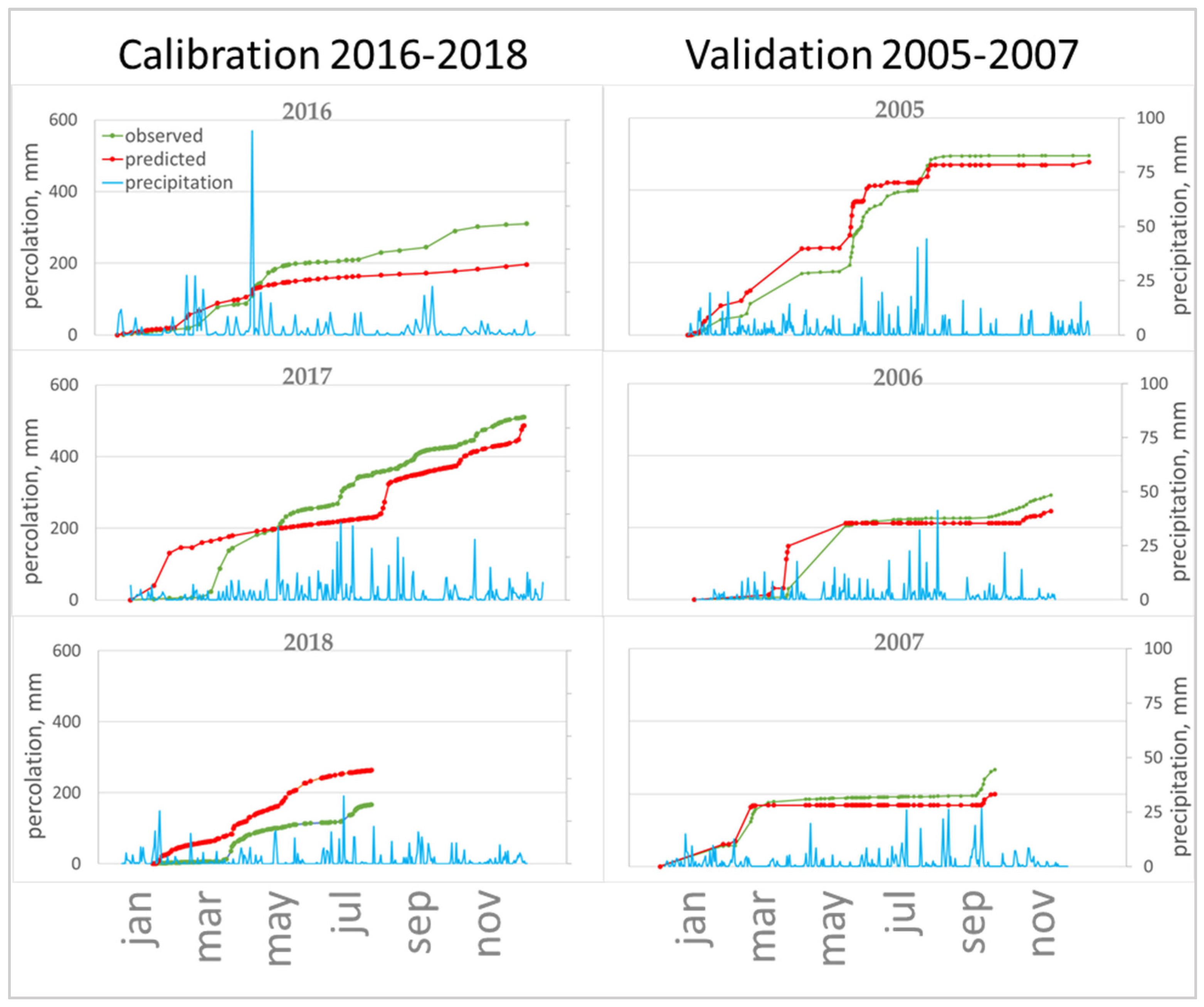

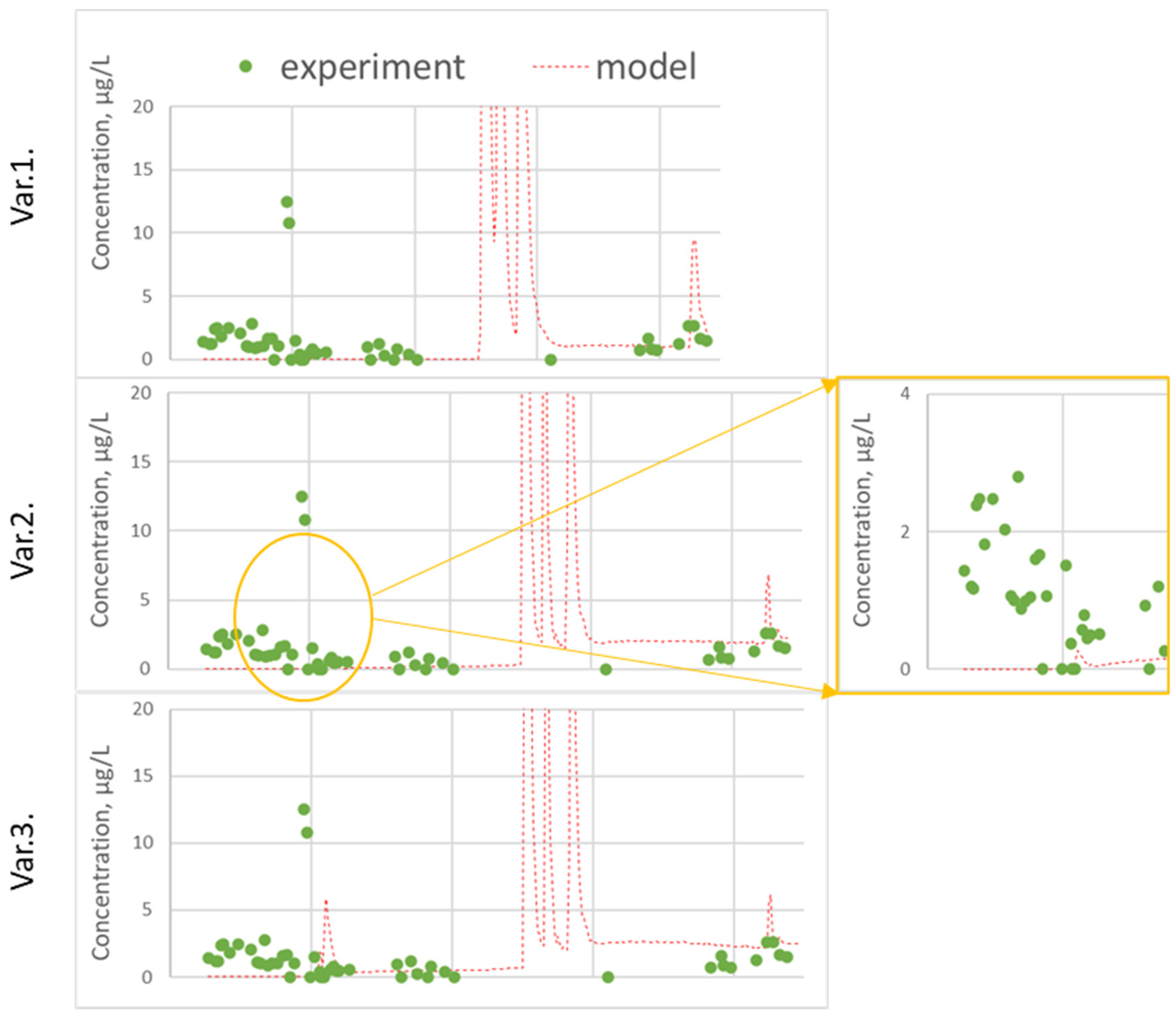
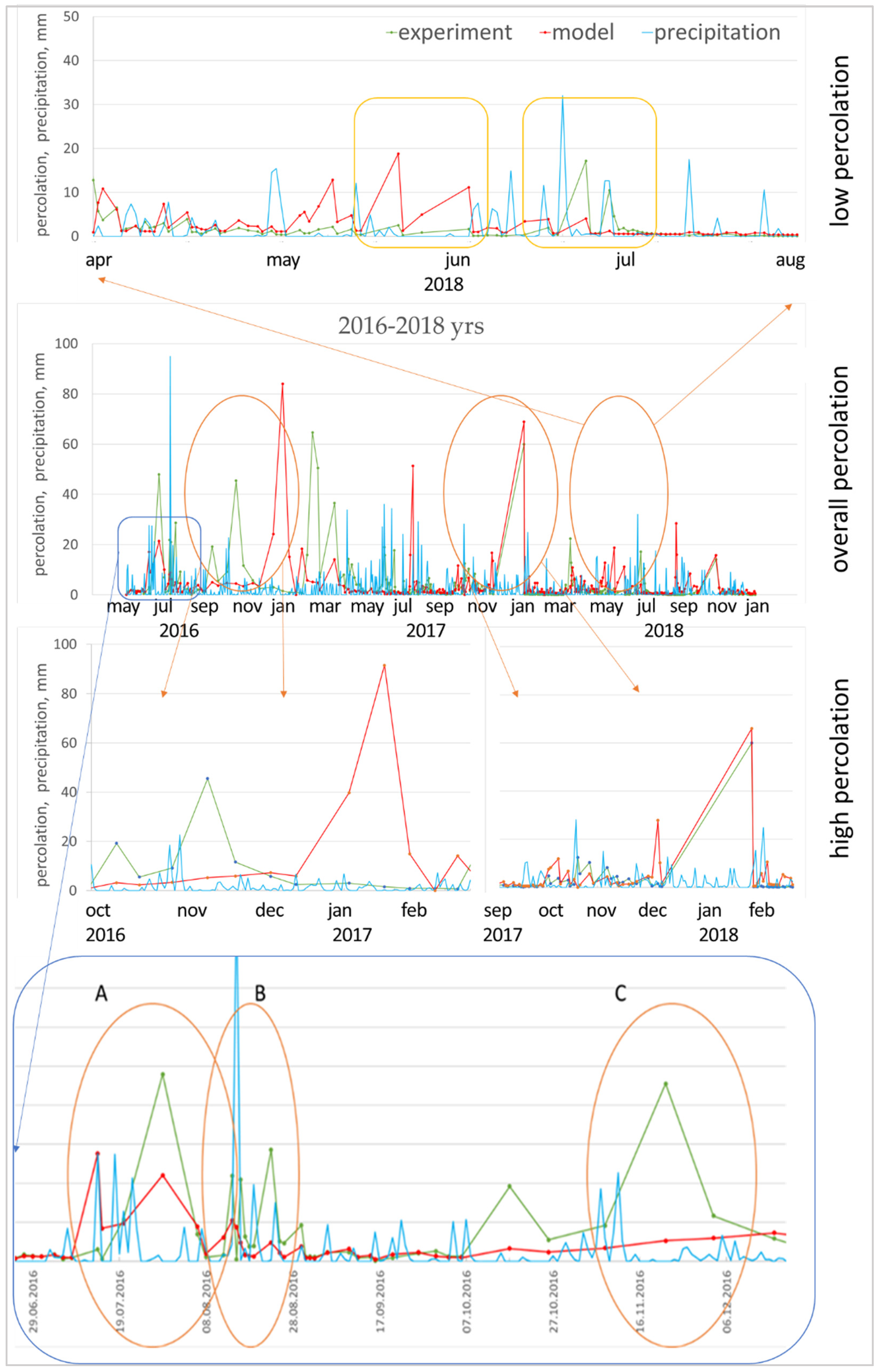
| Parameters 1 | A | A’ | EL | B1 | B2 | B3 |
|---|---|---|---|---|---|---|
| Depth, cm | 0–10 | 10–20 | 20–40 | 40–60 | 60–80 | 80–150 |
| pH | 5.81 | 5.82 | 5.73 | 5.73 | 4.50 | 4.50 |
| OC, % | 2.52 | 1.70 | 0.77 | 0.65 | 0.60 | 0.81 |
| Bulk density, g/cm3 | 1.12 | 1.28 | 1.35 | 1.49 | 1.50 | 1.56 |
| Fraction (kg/kg) mineral parts: | ||||||
| Clay (<2 μm) | 11.3 | 11.2 | 7.0 | 7.3 | 7.2 | 6.8 |
| Silt (2–50 μm) | 84.8 | 85.3 | 89.8 | 87.8 | 87.0 | 76.5 |
| Sand (>50 μm) | 3.9 | 3.5 | 3.2 | 4.9 | 5.8 | 16.7 |
| Parameters 1 | Description | A | A’ | EL | B1 | B2 | B3 |
|---|---|---|---|---|---|---|---|
| ALPHA | Van Genuchten’s α., cm−1 | 0.0265 | 0.0265 | 0.0269 | 0.0191 | 0.0215 | 0.0180 |
| ASCALE | Effective diffusion pathlength, mm | 20 | 20 | 35 | 50 | 50 | 50 |
| CTEN | Boundary soil water tension the boundary between micropores and macropores, cm | 12 | 12 | 10 | 10 | 10 | 10 |
| KSATMIN | Saturated hydraulic conductivity, mm/hours | 29.17 | 29.17 | 22.50 | 15.00 | 7.50 | 3.33 |
| KSM | Boundary hydraulic conductivity, mm/hours | 0.15 | 0.15 | 0.15 | 0.05 | 0.05 | 0.05 |
| N | Van Genuchten’s N, % | 1.2487 | 1.2487 | 1.0195 | 1.2619 | 1.2568 | 1.2601 |
| RESID | Residual water content, % | 0.05 | 0.05 | 0.01 | 0.04 | 0.07 | 0.01 |
| STONE | Stone content, % | 0 | 0 | 0 | 0 | 0 | 0 |
| TPORV | Saturated water content, % | 48.50 | 48.50 | 43.60 | 42.53 | 43.55 | 42.71 |
| TRAP_AIR | Trapped air content, % | 0.05 | 0.05 | 0.05 | 0.05 | 0.05 | 0.05 |
| XMPOR | Boundary water content, % | 41.20 | 41.20 | 40.30 | 39.23 | 40.25 | 39.41 |
| ZA | the exponent in the power function relating macropore hydraulic conductivity to macroporosity | 1 | 1 | 1 | 1 | 1 | 1 |
| ZM | Tortuosity factor (micropores) | 0.5 | 0.5 | 0.5 | 0.5 | 0.5 | 0.5 |
| ZN | Pore size distribution factor (macropores) | 3 | 3 | 3 | 2 | 2 | 2 |
| ZP | Slope of the shrinkage characteristic | 0 | 0 | 0 | 0 | 0 | 0 |
| Number | The Version | TPORV | RESID | ALPHA | N | XMPOR | CTEN | KSM | KSAT MIN | ASCALE | ZN |
|---|---|---|---|---|---|---|---|---|---|---|---|
| 1 | PTF | + | + | + | + | + | + | + | + | + | |
| 2 | + the macropores on tomography | + | |||||||||
| 3 | CTEN +50% | + | + | ||||||||
| 4 | CTEN = 10 cm | + | + | ||||||||
| 5 | the macropores +100% | + | + | ||||||||
| 6 | start 11.06.2014 | + | + | ||||||||
| 7 | start 11.06.2016 | + | + | ||||||||
| 8 | Zn = 2 | + | + | + | |||||||
| 9 | Zn = 4 | + | + | + | |||||||
| 10 | KSM as per PTF | + | + | + | + | ||||||
| 11 | KSM = 0.05 | + | + | + | + | ||||||
| 12 | KSM = 0.03 | + | + | + | + | ||||||
| 13 | ASCALE 30 | + | + | + | + | + | |||||
| 14 | KSATMIN +50% | + | + | + | + | + | + | ||||
| 15 | N +100% | + | + | + | + | + | + | ||||
| 16 | ALPHA +100% | + | + | + | + | + | + | + | |||
| 17 | KSM = 0.05, ALPHA and N +100% | + | + | + | + | + | + | + | |||
| 18 | KSM = 0.05, ALPHA +100% | + | + | + | + | + | + | ||||
| 19 | N +100% only in layer 0–20 cm | + | + | + | + | + | + | + | |||
| 20 | ALPHA и N +100% only in layer 0–20 cm | + | + | + | + | + | + | + |
| The Version | EF | CRM | RMSE |
|---|---|---|---|
| Without calibration | 0.407 | 0.469 | 143.081 |
| PTF | −0.429 | 0.736 | 222.070 |
| + the macropores on tomography | 0.423 | 0.462 | 141.076 |
| CTEN +50% | 0.260 | 0.527 | 159.767 |
| CTEN = 10 cm | 0.489 | 0.433 | 132.789 |
| the macropores +100% | 0.540 | 0.411 | 126.045 |
| start 11.06.2014 | 0.540 | 0.411 | 126.047 |
| start 11.06.2016 | 0.421 | 0.472 | 141.317 |
| Zn = 2 | 0.573 | 0.394 | 121.445 |
| Zn = 4 | 0.496 | 0.434 | 131.871 |
| KSM as per PTF | 0.174 | 0.560 | 168.859 |
| KSM = 0.05 | 0.834 | 0.234 | 75.707 |
| KSM = 0.03 | 0.911 | 0.160 | 55.539 |
| ASCALE 30 | 0.917 | 0.153 | 53.533 |
| KSATMIN +50% | 0.919 | 0.150 | 53.030 |
| N +100% | 0.918 | 0.161 | 53.286 |
| ALPHA +100% | 0.988 | 0.020 | 19.997 |
| KSM = 0.05, ALPHA and N +100% | 0.964 | 0.105 | 35.236 |
| KSM = 0.05, ALPHA +100% | 0.962 | 0.089 | 36.127 |
| N +100% only in layer 0–20 cm | 0.989 | −0.005 | 19.780 |
| ALPHA и N +100% only in layer 0–20 cm | 0.988 | −0.007 | 19.936 |
| Parameters | 2006 | 2007 | 2008 | 2016 | 2017 | 2018 | Climatic Norm |
|---|---|---|---|---|---|---|---|
| Monthly average temperatures, °C | |||||||
| 1 | −10.7 | −1.4 | −4.3 | −9.8 | −7.2 | −4.5 | −6.5 |
| 2 | −12.3 | −10.1 | −8.6 | −0.3 | −4.2 | −8.8 | −6.7 |
| 3 | −3.3 | 5.0 | −5.0 | 0.8 | 2.9 | −5.0 | −1.0 |
| 4 | 6.2 | 6.2 | 8.6 | 8.6 | 5.9 | 8.6 | 6.7 |
| 5 | 13.0 | 16.4 | 16.6 | 15.4 | 11.7 | 16.6 | 13.2 |
| 6 | 18.4 | 17.9 | 17.5 | 18.6 | 14.8 | 17.5 | 17.0 |
| 7 | 18.7 | 19.4 | 20.8 | 21.5 | 18.5 | 20.8 | 19.2 |
| 8 | 18.1 | 20.8 | 20.1 | 20.1 | 19.4 | 20.1 | 17.0 |
| 9 | 14.2 | 12.9 | 15.4 | 11.7 | 13.5 | 15.4 | 11.3 |
| 10 | 7.3 | 7.5 | 8.0 | 4.7 | 5.1 | 8.0 | 5.6 |
| 11 | 0.7 | −1.8 | −0.2 | −2.7 | 0.0 | −0.2 | −1.2 |
| 12 | 1.3 | −2.0 | −5.8 | −4.5 | −0.2 | −5.8 | −5.2 |
| Annual rainfall, mm | 730 | 640 | 693 | 939 | 885 | 634 | 640 |
| Amount of precipitation during the growing season, mm | 321 | 364 | 320 | 429 | 396 | 324 | |
| Sum of active temperatures, °C | 2632 | 2798 | 3016 | 2749 | 2342 | 3016 | |
| HTC * | 1.22 | 1.30 | 1.06 | 1.56 | 1.69 | 1.07 |
| Parameters | Ap-A-E-B-BC-C | Statistic Parameters | |||
|---|---|---|---|---|---|
| set2016 | |||||
| TPORV | 48.5-48.5-43.6-42.53-43.55-42.71 | Period | EF | SRMSE | CRM |
| XMPOR | 33.9-33.9-37-35.93-36.95-36.11 | 2005–2007 | 0.248 | 0.399 | −0.350 |
| TRAP AIR | 0.05-0.05-0.05-0.05-0.05-0.05 | 2005 | 0.742 | 0.279 | −0.250 |
| RESID | 0.05-0.05-0.05-0.05-0.05-0.05 | 2006 | −0.155 | 0.393 | −0.318 |
| N | 1.249-1.249-1.02-1.262-1.257-1.26 | 2007 | −0.296 | 0.256 | −0.176 |
| ALPHA | 0.053-0.053-0.0269-0.0191-0.0215-0.018 | 2016–2018 | 0.887 | 0.135 | 0.065 |
| KSATMIN | 29.17-29.17-22.5-15-7.5-3.33 | 2016 | 0.747 | 0.370 | 0.213 |
| KSM | 0.05-0.05-0.05-0.05-0.05-0.05 | 2017 | 0.768 | 0.169 | 0.082 |
| CTEN | 10-10-10-10-10-10 | 2018 | −1.906 | 1.151 | −1.001 |
| ASCALE | 30-30-30-30-30-30 | ||||
| ZN | 2-2-2-2-2-2 | ||||
| setPTF | |||||
| TPORV | 55.54-50-47.77-42.8-42.46-40.25 | Period | EF | SRMSE | CRM |
| XMPOR | 49.58-46.58-44.84-40.87-40.6-38.72 | 2005–2007 | 0.976 | 0.071 | 0.018 |
| TRAP AIR | 0.05-0.05-0.05-0.05-0.05-0.05 | 2005 | 0.912 | 0.163 | −0.087 |
| RESID | 0-0-0-0-0-0 | 2006 | 0.832 | 0.150 | 0.032 |
| N | 1.256-1.263-1.375-1.365-1.368-1.34 | 2007 | 0.650 | 0.133 | 0.104 |
| ALPHA | 0.017272-0.013918-0.009472-0.006962-0.006903-0.007931 | 2016–2018 | −1.077 | 0.579 | 0.539 |
| KSATMIN | 145.09-62.42-38.71-3.75-3.63-3.39 | 2016 | 0.519 | 0.510 | 0.326 |
| KSM | 0.523-0.517-0.586-0.618-0.641-0.969 | 2017 | −2.888 | 0.691 | 0.654 |
| CTEN | 10-10-10-10-10-10 | 2018 | 0.733 | 0.349 | −0.166 |
| ASCALE | 6-6-50-50-50-50 | ||||
| ZN | 2-2-2-2-2-2 | ||||
| setSoilLab | |||||
| TPORV | 48.5-48.5-43.6-42.53-43.55-42.71 | Period | EF | SRMSE | CRM |
| XMPOR | 41.2-41.2-40.3-39.23-40.25-39.41 | 2005–2007 | 0.924 | 0.127 | −0.115 |
| TRAP AIR | 0.05-0.05-0.05-0.05-0.05-0.05 | 2005 | 0.897 | 0.176 | −0.144 |
| RESID | 0.05-0.05-0.01-0.04-0.07-0.01 | 2006 | 0.832 | 0.150 | −0.056 |
| N | 1.2487-1.2487-1.0195-1.2619-1.2568-1.2601 | 2007 | 0.833 | 0.092 | 0.036 |
| ALPHA | 0.053-0.053-0.0269-0.0191-0.0215-0.018 | 2016–2018 | 0.022 | 0.397 | 0.370 |
| KSATMIN | 29.17-29.17-22.5-15-7.5-3.33 | 2016 | 0.560 | 0.488 | 0.291 |
| KSM | 0.15-0.15-0.15-0.05-0.05-0.05 | 2017 | −0.687 | 0.455 | 0.414 |
| CTEN | 12-12-10-10-10-10 | 2018 | 0.023 | 0.667 | −0.542 |
| ASCALE | 20-20-35-50-50-50 | ||||
| ZN | 3-3-3-2-2-2 | ||||
| setBalance | |||||
| TPORV | 55.54-50-47.77-42.8-42.46-40.25 | Period | EF | SRMSE | CRM |
| XMPOR | 49.58-46.58-44.84-40.87-40.6-38.72 | 2005–2007 | 0.690 | 0.256 | −0.229 |
| TRAP AIR | 0.05-0.05-0.05-0.05-0.05-0.05 | 2005 | 0.839 | 0.221 | −0.199 |
| RESID | 0.05-0.05-0.05-0.05-0.05-0.05 | 2006 | 0.526 | 0.252 | −0.186 |
| N | 1.256-1.263-1.375-1.365-1.368-1.34 | 2007 | 0.585 | 0.145 | −0.074 |
| ALPHA | 0.053-0.053-0.0269-0.0191-0.0215-0.018 | 2016–2018 | 0.870 | 0.145 | 0.093 |
| KSATMIN | 145.09-62.42-38.71-3.75-3.63-3.39 | 2016 | 0.771 | 0.352 | 0.189 |
| KSM | 0.05-0.05-0.05-0.05-0.05-0.05 | 2017 | 0.679 | 0.199 | 0.133 |
| CTEN | 10-10-10-10-10-10 | 2018 | −1.540 | 1.076 | −0.923 |
| ASCALE | 30-30-30-30-30-30 | ||||
| ZN | 2-2-2-2-2-2 | ||||
| Horizon Depth, cm | DEG (Degradation Rate), Day−1 | ZKD (Sorption Coefficient), cm−3 g | D (Dispersivity), cm |
|---|---|---|---|
| 0–10 | 0.0139 (0.0099–0.0139) | 9.8 (7.6–15.1) | 5 (5–50) |
| 10–20 | 0.0139 (0.00099–0.0139) | 6.6 (5.1–10.2) | 5 (5–50) |
| 20–40 | 0.0139 (0.0099–0.0139) | 1.5 (1.3–2.3) | 5 (5–50) |
| 40–60 | 0.0069 (0.0050–0.0069) | 1.3 (1.0–2.0) | 5 (5–50) |
| 60–80 | 0.0042 (0.0030–0.0069) | 0.7 (0.3–1.1) | 5 (5–50) |
| 80–150 | 0.0042 (0.0007–0.0058) | 0.3 (0.3–0.6) | 5 (5–50) |
| Horizon Depth, cm | 0–10 | 10–20 | 20–40 | 40–60 | 60–80 | 80–150 |
|---|---|---|---|---|---|---|
| Variant 1 | ||||||
| DT50, days | 50 | 50 | 50 | 100 | 100 | 167 |
| ZKD, cm3 g−1 | 9.8 | 6.6 | 1.5 | 1.3 | 0.7 | 0.4 |
| DV, cm | 5 | 5 | 5 | 5 | 5 | 5 |
| ASCALE, mm | 20 | 20 | 30 | 50 | 50 | 50 |
| Variant 2 | ||||||
| DT50, days | 60 | 60 | 60 | 120 | 120 | 200 |
| ZKD, cm3 g−1 | 7.6 | 5.1 | 1.2 | 1 | 0.5 | 0.3 |
| DV, cm | 50 | 50 | 50 | 50 | 50 | 50 |
| ASCALE, mm | 6 | 6 | 10 | 30 | 50 | 50 |
| Variant 3 | ||||||
| DT50, days | 60 | 60 | 60 | 120 | 120 | 120 |
| ZKD, cm3 g−1 | 7.6 | 5.1 | 1.2 | 1 | 0.3 | 0.3 |
| DV, cm | 50 | 50 | 50 | 50 | 50 | 50 |
| ASCALE, mm | 6 | 6 | 10 | 30 | 50 | 50 |
| Statisctic Parameters | Without Calibration (DT50 = 49.9 Days; Koc = 387 cm3 g−1; DV = 5 cm). | DT50 = 60 Days; Koc = 300 cm3 g−1; DV = 50 cm. | DT50 = 60 Days; Koc = 300 cm3 g−1; DV = 50 cm + Changed DT50 and Koc in 120–150 cm. | |
| Var. 1. | Var. 2. | Var. 3. | ||
| Total content in soil | SRMSE | 0.26 | 0.28 | 0.26 |
| EF | 0.84 | 0.81 | 0.84 | |
| CRM | −0.15 | −0.20 | −0.15 | |
| Distribution in soil | All dates | |||
| SRMSE | 0.54 | 1.25 | 1.13 | |
| EF | 1.00 | 0.97 | 0.98 | |
| CRM | 0.23 | 0.45 | 0.43 | |
| 04.06.2016 | ||||
| SRMSE | 0.96 | 0.87 | 0.87 | |
| EF | −0.41 | −0.16 | −0.15 | |
| CRM | −0.74 | −0.67 | −0.67 | |
| Ho/Hp * | 10.2/13.8 | 10.6/13.8 | 10.2/13.8 | |
| 11.10.2016 | ||||
| SRMSE | 1.01 | 0.52 | 0.56 | |
| EF | 0.17 | 0.78 | 0.74 | |
| CRM | −0.10 | −0.16 | −0.15 | |
| Ho/Hp | 6.3/12.3 | 7.6/12.3 | 7.4/12.3 | |
| 11.05.2017 | ||||
| SRMSE | 0.11 | 0.09 | 0.09 | |
| EF | −0.15 | 0.22 | 0.21 | |
| CRM | −0.65 | −0.50 | −0.51 | |
| Ho/Hp | 20.0/13.6 | 15.4/13.6 | 15.2/13.6 | |
| In leachate (17.06.2015–06.08.2016) | SRMSE | 1.89 | 1.76 | 1.82 |
| EF | 0.59 | 0.38 | 0.47 | |
| CRM | 0.67 | 0.67 | 0.43 | |
| Cav(O/P) ** | 1.5/0.0 | 1.5/0.5 | 1.5/0.9 | |
| Cmed (O/P) *** | 1.0/0.6 | 1.0/0.0 | 1.0/0.5 | |
| C80% (O/P) **** | 1.8/0.5 | 1.8/1.2 | 1.8/2.3 | |
| In leachate (17.06.2015–15.06.2017) | SRMSE | 33.88 | 5.23 | 4.99 |
| EF | 716.42 | 16.06 | 14.56 | |
| CRM | −442.78 | −60.19 | −69.23 | |
| Cav (O/P) ** | 1.6/0.5 | 1.6/3.0 | 1.6/3.3 | |
| Cmed (O/P) *** | 1.2/0.0 | 1.2/0.2 | 1.2/4.5 | |
| C80% (O/P) **** | 2.4/0.0 | 2.4/3.9 | 2.4/4.3 | |
Publisher’s Note: MDPI stays neutral with regard to jurisdictional claims in published maps and institutional affiliations. |
© 2022 by the authors. Licensee MDPI, Basel, Switzerland. This article is an open access article distributed under the terms and conditions of the Creative Commons Attribution (CC BY) license (https://creativecommons.org/licenses/by/4.0/).
Share and Cite
Kolupaeva, V.; Kokoreva, A.; Belik, A.; Bolotov, A.; Glinushkin, A. Modelling Water and Pesticide Transport in Soil with MACRO 5.2: Calibration with Lysimetric Data. Agriculture 2022, 12, 505. https://doi.org/10.3390/agriculture12040505
Kolupaeva V, Kokoreva A, Belik A, Bolotov A, Glinushkin A. Modelling Water and Pesticide Transport in Soil with MACRO 5.2: Calibration with Lysimetric Data. Agriculture. 2022; 12(4):505. https://doi.org/10.3390/agriculture12040505
Chicago/Turabian StyleKolupaeva, Victoria, Anna Kokoreva, Alexandra Belik, Andrei Bolotov, and Alexey Glinushkin. 2022. "Modelling Water and Pesticide Transport in Soil with MACRO 5.2: Calibration with Lysimetric Data" Agriculture 12, no. 4: 505. https://doi.org/10.3390/agriculture12040505






